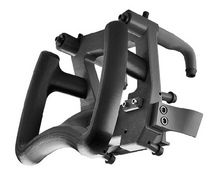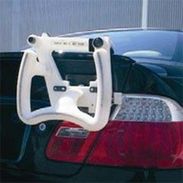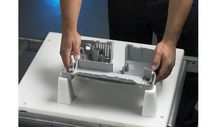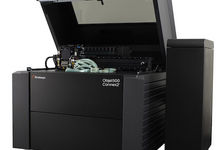- Commercial 3D printers & additive manufacturing solutions
- Order sample print
3D Printed Jigs and Fixtures
Streamline production and customize your Manufacturing Tooling by 3D printing on the fly Jigs and Fixtures with FDM and PolyJet 3D PrintersThe 3D Printed Jigs and Fixtures is great for:
- For complex or organic designs
- When design changes are likely
- Only need a low quantity of tools produced
Overview
3D Printed Jig Manufacturing relies on tools, including jigs, fixtures, templates and gauges, to maintain quality and production efficiency. These manufacturing tools are used to align, assemble, clamp, hold, test and calibrate components and sub–assemblies at all stages of the manufacturing process. And although these tools are virtually invisible when production is running smoothly, their importance becomes evident when problems arise. To avoid production halts or product defects, new manufacturing tools must be rapidly designed, manufactured and deployed.
Manufacturing tools are most commonly machined or fabricated from metal, wood or plastic. Like the items they help produce, these tools go through the design, documentation, production and inspection processes. Geometries are limited by the machining and fabrication processes and equipment capabilities. Elaborate or intricate tools may require several cycles of design, prototyping and evaluation to reach the required performance. On average, each iteration of manufacturing tooling takes between one and four weeks to design and build.
Application Checklist
PolyJet or FDM is a best fit for jigs and fixtures when:
- Designs are complex or organic
- Quantity is less than 100, ideally less than 25
- Tolerance is at least +/- 0.005 in.
- Design changes are likely
Benefits of PolyJet and FDM jigs and fixtures include:
- Lead times reduced by 40 to 80 percent
- Cost reduced by 70 to 95 percent
- Integrated design (part consolidation), eliminating assembly and improving performance and accuracy
- Design freedom for improved function and ergonomics
- Streamlined process
Application Outline - PolyJet and FDM
PolyJet and FDM Technology, both available from SMG3D through Stratasys & Objet 3D Printers, provide fast and accurate methods to produce and manufacture tools. 3D printing jigs and fixtures with PolyJet or FDM can help reduce the backlog for an in-house machine shop and be used as a bridge–to–tooling solution.
In some instances, especially during the design cycle, manufacturing tools are required to make a component for an alpha or beta phase of a product. During this interim, 3D printing can help prove designs without long lead times and complicated machined tools.
Building tools with 3D printing frees designers from conventional manufacturing constraints, resulting in better function and ergonomics.
Stratasys 3D printing materials combine strength, durability and surface quality, so users can create a large spectrum of tools including (but not limited to) almost any tool traditionally made from plastic. Fixtures can now be built overnight, allowing for next–day use. Materials are available that can bear large forces and high temperatures and are chemically resistant.
Customer Story - PolyJet
While building their own Eden line of professional PolyJet technology–based 3D printers, Stratasys (then Objet) engineers designed a fixture to guide the bearing shaft into its proper location using strong static magnets. For precise, repeatable shaft positioning, the magnets attract the shaft into a V-block. The 6–kg shaft load would sit high above the attraction magnets, so it was not clear how easily the jig operator would be able to apply the attraction force, and how smooth and effective the force would be. Also, magnetic attraction abruptly drops a small distance from the attracted object, and designers wondered whether this posed a risk.
The 3D printed jig illuminated changes required at the machine level and the jig level for the project to succeed. The material cost of the jig was much lower than the price of the traditional tool - a small price for risk reduction. The cost of fixing the errors at the final product level (which would have been necessary without the 3D printed jig) was very high. More significantly, the delay would have been six weeks.
Customer Story - FDM
The Oreck Corporation produces lightweight, durable and easy–to–use cleaning products for every room in the house. Before production begins for a new item, Oreck’s quality assurance department must complete a first–article inspection of its components. Twenty to 30 injection-molded parts typically appear on the bill of materials. The department uses coordinate measuring machines (CMMs) to be sure the parts meet Oreck’s demanding requirements.
Previously, first–article inspection would span 30 days - a few days for inspection and many weeks of preparation, setup, programming and waiting. Using FDM to make CMM fixtures and inspection samples, Oreck now finishes first–article inspections within days of receiving parts from production tooling.
To complete the inspections, Oreck first must program the CMM, which takes two to four hours per part. For the average assembly, this is two weeks of work. But programming can’t be done without fixtures and sample parts. For simple parts, modular clamps act as fixtures. Complex parts required machined fixtures with lead times of 7 to 10 days. And Oreck could not begin the programming until the injection mold began producing parts.
Oreck now uses FDM to make fixtures and sample parts while the injection mold is being constructed, meaning all programming and setup happens before molded parts arrive. By removing programming from the critical path, Oreck condensed its inspection lead time to just a few days. According to Craig Ulmer, senior quality assurance labs technician, the average FDM fixture takes just three to four hours to make and costs just $55.
“I found it was very easy to design the fixtures in CAD software based on the CAD model of the part to be inspected,” said Ulmer. Technicians now build fixtures as soon as the design is frozen. “I can now easily inspect all of the first articles for a new product in one day as opposed to one month,” Ulmer said. “This means we can give the go–ahead to start production one month earlier than in the past.”
 Worcester (Head Office) 01905 458 000
Worcester (Head Office) 01905 458 000 3d@stanfordmarsh.co.uk
3d@stanfordmarsh.co.uk















